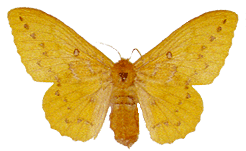|
Trabala
krishna Roepke
Trabala krishna Roepke, 1951: 117.
|

Trabala krishna ♂
(natural
size)

Trabala krishna ♀
(natural
size) |

|
Diagnosis. The male is bright green with a strong discal spot and
submarginal spots, the latter with a marked central 'step' and acutely
dentate distad. The fasciae are yellowish, crenulate on both surfaces. The
fringes, particularly of the hindwing, are crenulate and darkly edged. The
uncus has two well separated and slender prongs; the aedeagus apex is only
weakly produced. For diagnosis of the female see the previous species: the
submarginal spots are perhaps never pale-centred; those anterior to the
hindwing 'step' are weaker than the rest as in the male.
Geographical range. Sundaland.
Habitat preference. The species is less common than the previous but is
recorded from a similar range of lowland habitats; three weakly marked
males were taken by T.P.G. Helps in mangrove in Brunei.
Biology. Host-plants given by Roepke are Barringtonia,
Melastoma, Psidium and Ziziphus. The species has been
reared from Macaranga (Euphorbiaceae) in Peninsular Malaysia. The
larvae crowd on the trunk during the day, moving up to feed on the foliage
at night (Tho Yow Pong, pers. comm.).
<<Back
>>Forward <<Return
to Contents page
|

